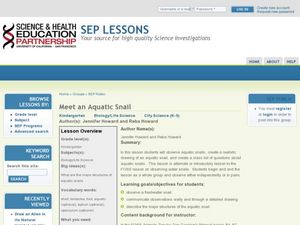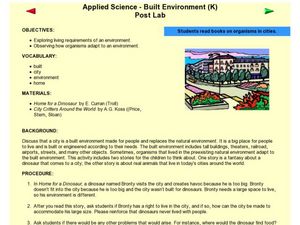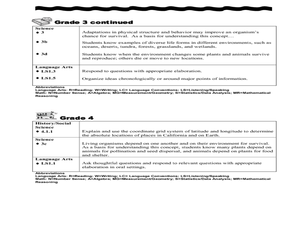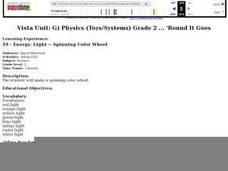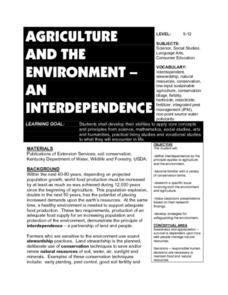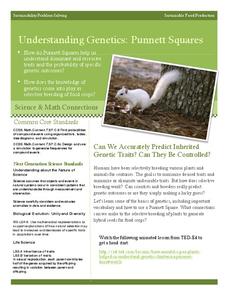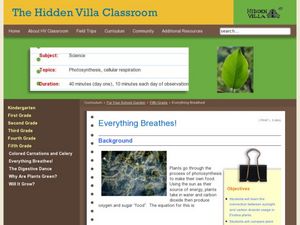Curated OER
It's a Wrap!
Students read about the importance of packaging foods and related items properly and reducing waste. In this packaging lesson, students read the background information about packaging and bring a variety of packaging materials to class....
Curated OER
The Giant Barrel Sponge
Learners study barrel sponges. In this science and art lesson, students discuss what sponges are, create their own sponge, and share what they created with the rest of the class.
Curated OER
Biomass: The Energy of the Future
Students research renewable fuels. In this alternative energy lesson, students compile information and create a comparison chart on renewable resources. This lesson includes additional suggested readings, vocabulary, and a Biomass...
Curated OER
Climate
Students study zoanthids. In this science and art lesson, students use line to create texture and how to use colors to create value. Students share their beautiful mat zoanthids with the rest of the class.
Curated OER
Limu Party
Students explore limu in their everyday lives. In this science lesson, students identify various uses of limu and discuss common household products that contain limu. Students participate in a limu party.
Curated OER
Meet an Aquatic Snail
Students explore aquatic snails. In this life science lesson, students create a class list of questions about aquatic snails and begin to observe aquatic snails in the classroom. Students record observations.
Curated OER
Organisms In Cities
Students explore environments and how organisms adapt to the environment. In this science lesson, students read a story and discuss how animals have adapted to changes in their environment.
Curated OER
Earth Pockets
Students identify the Earth's natural resources. In this Earth science lesson plan, students read the book The Great Kapok Tree and discuss types of natural resources. Students use categories such as wood, paper, and trees and list items...
Curated OER
Ocean Grazers Conclusion
Students research an ocean species. In this science lesson, students create a research presentation as a conclusion to the ocean grazers unit. Students present their projects to the class and complete a self-reflection paper.
Curated OER
Who? Who? Whoooooooo?
Students read Poppy by Avi and then dissect an owl pellet. They complete a KWL chart and play vocabulary games to prepare for the dissection. They examine what the pellet can tell us about the owl's life.
Curated OER
It's all Interconnected
Students participate in a number of activities to investigate the food web, species extinction, predators and prey, and biological diversity.
Curated OER
Create a Hawaiian Tako Lure
Students create a tako lure. In this Hawaiian culture lesson, students research how Hawaiians use natural resources to survive. Students are introduced to new vocabulary and create an octopus lure.
Curated OER
Life Cycle of Brassica Plants: Planting Seeds
Students explore botany by participating in a calendar class activity. In this plant observation lesson, students examine a diagram of a Brassica plant and identify its anatomy before planting their own seeds and viewing the changes over...
Curated OER
Matters of Milk and Marshmallows
Young scholars observe a teacher demonstration o classifying matter by its physical properties of shape and size. After discussing the definition of matter, students describe the state of matter. They sing a song to the tune of "Bingo."...
Curated OER
Living On Earth
Students discover the many different animals within various habitats and discover how each individual species interacts with its particular environment. Through charting different animals and their distinct habitat and matching animals...
Curated OER
Energy: Light -- Spinning Color Wheel
Second graders make spinning color wheels to determine how energy effects what colors look like. They paint or color a color wheel with the seven colors of the spectrum. Next, the spin the wheel to determine what happens. In order to...
Curated OER
Strawberry DNA extraction
Students study the basic function of DNA and then extract it from strawberries. In this DNA extraction lesson students examine DNA and see why the extraction of it is so important to scientists.
Curated OER
Environmental Science/Water Pollution
Learners study natural habitats, aquatic life, renewable and non-renewable resources. They discuss conservation efforts for sea otters and desert toad in this units.
Curated OER
Wild Where?
Students investigate why the urban environment is considered a hostile environment; define the concept of endangered species; describe and identify a Peregrine Falcon; describe and identify the eating habits of the Peregrine Falcon.
Curated OER
Agriculture and the Environment
Young scholars investigate the interdependence of agriculture and the environment. They research areas of interdependence and provide examples of situations where farmers are practicing conservation in the local area. Their findings are...
Curated OER
Bird Brilliance!
First graders explore natural resources and search outdoors to find materials to create a bird's nest. In this bird's natural resources lesson, 1st graders listen to a book about birds and reflect on the various things birds use to...
Western Kentucky University
Understanding Genetics: Punnett Squares
Can scientists really predict genetic outcomes or are they simply making a lucky guess? Scholars first learn about Gregor Mendel and how to make Punnett squares. Then they extract DNA from a strawberry in a lab with included conclusion...
Curated OER
Everything Breathes!
Fifth graders test plants in the dark and in the light to see which grows better and produces more carbon dioxide. In this plants lesson plan, 5th graders also create ways for plants to go through photosynthesis that they can observe.
Melissa Institute for Violence Prevention and Treatment
Concept Muraling
Concept muraling helps learners improve their comprehension of a text by giving them a way to organize their understanding of the key concepts in that text. Introduce readers to this process with a carefully scaffolded instructional...





